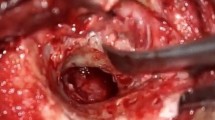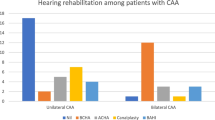Abstract
The present study aimed to determine favorable prognostic factors for long-term postoperative hearing outcome after canal-tympanoplasty for congenital aural atresia (CAA). We retrospectively reviewed pre and postoperative hearing results and image findings of 51 ears with CAA performed by canal-tympanoplasty for primary repair. Averages of the postoperative air and bone-conduction thresholds, and the air–bone gap (ABG) were calculated from the last pure-tone audiometry. Follow-up duration ranged from 16 to 139 months. A successful hearing result was defined as a postoperative ABG of ≤15 dB, or a postoperative pure-tone average of ≤30 dB. The influence of the following factors on the success of surgery was assessed by multivariate logistic regression analysis: total Jahrsdoerfer grading system score, age at surgery, and dimensions of middle ear including incudostapedial joint angulation, mesotympanic height, mesotympanic width, mesotympanic depth, mesotympanic area, mesotympanic volume, reconstructable external auditory canal (EAC) diameter, and reconstructable EAC height. Successful hearing outcomes were achieved in 24 of 51 ears (47.1 %). A multivariate logistic regression analysis showed that an EAC area >72.3 mm2 was the most significant favorable predictive factor (P = 0.006), followed by mesotympanic depth >5.5 mm (P = 0.013), mesotympanic height >4.6 mm (P = 0.016), and EAC diameter >9.5 mm (P = 0.029). In conclusion, the size of the reconstructable EAC and mesotympanum is important for predicting long-term favorable hearing outcome following canal-tympanoplasty for CAA.

Similar content being viewed by others
References
De la Cruz A, Teufert KB (2003) Congenital aural atresia surgery: long-term results. Otolaryngol Head Neck Surg 129(1):121–127
Ishimoto S et al (2007) Hearing levels in patients with microtia: correlation with temporal bone malformation. Laryngoscope 117(3):461–465
Dedhia K et al (2012) Anatomic variants on computed tomography in congenital aural atresia. Otolaryngol Head Neck Surg 147(2):323–328
Ishimoto S et al (2004) The role of the external auditory canal in the development of the malleal manubrium in humans. Arch Otolaryngol Head Neck Surg 130(8):913–916
Ishimoto S et al (2005) Correlation between microtia and temporal bone malformation evaluated using grading systems. Arch Otolaryngol Head Neck Surg 131(4):326–329
Yeakley JW, Jahrsdoerfer RA (1996) CT evaluation of congenital aural atresia: what the radiologist and surgeon need to know. J Comput Assist Tomogr 20(5):724–731
Yellon RF, Branstetter BF (2010) Prospective blinded study of computed tomography in congenital aural atresia. Int J Pediatr Otorhinolaryngol 74(11):1286–1291
Yu Z et al (2008) Facial nerve course in congenital aural atresia––identified by preoperative CT scanning and surgical findings. Acta Otolaryngol 128(12):1375–1380
Chandrasekhar SS, De la Cruz A, Garrido E (1995) Surgery of congenital aural atresia. Am J Otol 16(6):713–717
Chang SO et al (2002) Prevention of postoperative meatal stenosis with anteriorly and inferiorly based periosteal flaps in congenital aural atresia surgery. Otol Neurotol 23(1):25–28
Digoy GP, Cueva RA (2007) Congenital aural atresia: review of short- and long-term surgical results. Otol Neurotol 28(1):54–60
El-Hoshy Z, Abdel-Aziz M, Shabana M (2008) Congenital aural atresia: transmastoid approach; an old technique with good results. Int J Pediatr Otorhinolaryngol 72(7):1047–1052
Lambert PR (1998) Congenital aural atresia: stability of surgical results. Laryngoscope 108(12):1801–1805
Nishizaki K, Masuda Y, Karita K (1999) Surgical management and its post-operative complications in congenital aural atresia. Acta Otolaryngol Suppl 540:42–44
Teufert KB, De la Cruz A (2004) Advances in congenital aural atresia surgery: effects on outcome. Otolaryngol Head Neck Surg 131(3):263–270
Chang SO, Choi BY, Hur DG (2006) Analysis of the long-term hearing results after the surgical repair of aural atresia. Laryngoscope 116(10):1835–1841
Oliver ER et al (2010) Middle ear dimensions in congenital aural atresia and hearing outcomes after atresiaplasty. Otol Neurotol 31(6):946–953
Kim DW et al (2011) Continuity of the incudostapedial joint: a novel prognostic factor in postoperative hearing outcomes in congenital aural atresia. Acta Otolaryngol 131(7):701–707
Mishiro Y et al (2009) Prognostic factors for short-term outcomes after ossiculoplasty using multivariate analysis with logistic regression. Arch Otolaryngol Head Neck Surg 135(8):738–741
Mishiro Y et al (2010) Prognostic factors of long-term outcomes after ossiculoplasty using multivariate analysis. Eur Arch Otorhinolaryngol 267(6):861–865
Yeakley JW et al (1992) Grading system for the selection of patients with congenital aural atresia. Am J Otol 13(1):6–12
Conflict of interest
The authors have no conflict of interest to declare.
Author information
Authors and Affiliations
Corresponding author
Rights and permissions
About this article
Cite this article
Sakamoto, T., Kikuta, S., Kikkawa, Y.S. et al. Prognostic factors for long-term hearing preservation after canal-tympanoplasty for congenital aural atresia. Eur Arch Otorhinolaryngol 272, 3151–3156 (2015). https://doi.org/10.1007/s00405-014-3164-6
Received:
Accepted:
Published:
Issue Date:
DOI: https://doi.org/10.1007/s00405-014-3164-6




